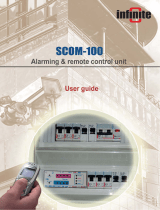
List drive slots................................................................................................................................................................ 24
List fans.......................................................................................................................................................................... 25
List power supply units................................................................................................................................................. 26
List temperature sensors..............................................................................................................................................26
List voltage sensors.......................................................................................................................................................27
List current sensors.......................................................................................................................................................28
List failed drives............................................................................................................................................................. 28
Informational commands.................................................................................................................................................... 29
Show adapter information............................................................................................................................................29
Show drive information.................................................................................................................................................29
Show enclosure information.........................................................................................................................................30
Show firmware file information.....................................................................................................................................31
View event log ............................................................................................................................................................... 31
View MD3060e SAS diagnostics................................................................................................................................. 32
6 Update commands......................................................................................................................33
Update drive firmware........................................................................................................................................................ 33
Update EMM firmware....................................................................................................................................................... 34
Update Adapter................................................................................................................................................................... 35
Status Adapter.....................................................................................................................................................................35
Global Topology................................................................................................................................................................... 35
7 Monitoring ................................................................................................................................ 37
Logging or Monitor Service ...............................................................................................................................................37
Local log file..........................................................................................................................................................................38
Windows event log .............................................................................................................................................................38
Linux syslog.......................................................................................................................................................................... 38
Monitor Configuration File..................................................................................................................................................38
Logging Functionality Modification Directions...........................................................................................................38
SNMP....................................................................................................................................................................................39
Events................................................................................................................................................................................... 39
JBOD LEDs...........................................................................................................................................................................40
8 Dell Storage enclosure REST API..................................................................................................41
Modifying REST Configuration...........................................................................................................................................41
Accessing the REST service.............................................................................................................................................. 42
SHM REST Resources........................................................................................................................................................42
Device Inventory............................................................................................................................................................42
Firmware Updates......................................................................................................................................................... 43
Device Actions............................................................................................................................................................... 44
Firmware File Information.............................................................................................................................................44
Object Aliases.................................................................................................................................................................44
Device inventory............................................................................................................................................................ 44
Updating firmware by using REST.................................................................................................................................... 46
9 Microsoft System Center Operations Manager Management Pack ................................................. 47
Overview of the Dell Storage PowerTools Server Hardware Manager SCOM management pack ........................ 47
Installing Dell Storage PowerTools Server Hardware Manager SCOM Management Pack......................................47
Views created ..................................................................................................................................................................... 48
4
Contents






















